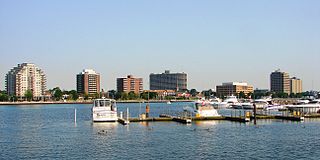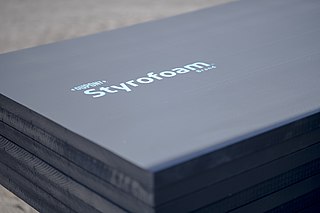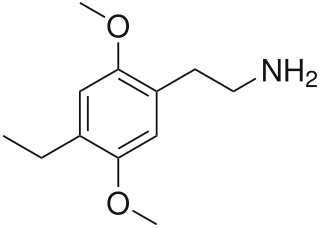
Sarnia is a city in Lambton County, Ontario, Canada. It had a 2021 population of 72,047, and is the largest city on Lake Huron. Sarnia is located on the eastern bank of the junction between the Upper and Lower Great Lakes where Lake Huron flows into the St. Clair River in the Southwestern Ontario region, which forms the Canada–United States border, directly across from Port Huron, Michigan. The site's natural harbour first attracted the French explorer La Salle. He named the site "The Rapids" on 23 August 1679, when he had horses and men pull his 45-ton barque Le Griffon north against the nearly four-knot current of the St. Clair River.

Styrofoam is a trademarked brand of closed-cell extruded polystyrene foam (XPS), manufactured to provide continuous building insulation board used in walls, roofs, and foundations as thermal insulation and water barrier. This material is light blue in color and is owned and manufactured by DuPont. DuPont also has produced a line of green and white foam shapes for use in crafts and floral arrangements.

Union Carbide Corporation is an American chemical corporation wholly owned subsidiary by Dow Chemical Company. Union Carbide produces chemicals and polymers that undergo one or more further conversions by customers before reaching consumers. Some are high-volume commodities and others are specialty products meeting the needs of smaller markets. Markets served include paints and coatings, packaging, wire and cable, household products, personal care, pharmaceuticals, automotive, textiles, agriculture, and oil and gas. The company is a former component of the Dow Jones Industrial Average.

The Dow Chemical Company, officially Dow Inc., is an American multinational corporation headquartered in Midland, Michigan, United States. The company is among the three largest chemical producers in the world.

2C-E is a psychedelic phenethylamine of the 2C family. It was first synthesized by Alexander Shulgin and documented in his book PiHKAL. Like the other substances in its family, it produces sensory and cognitive effects in its physical reactions with living organisms.

Herbert Henry Dow was a Canadian-born American chemical industrialist who founded the American multinational conglomerate Dow Chemical. He was a graduate of Case School of Applied Science in Cleveland, Ohio. He was a prolific inventor of chemical processes, compounds, and products, and was a successful businessman.

Chlorpyrifos (CPS), also known as Chlorpyrifos ethyl, is an organophosphate pesticide that has been used on crops, animals, and buildings, and in other settings, to kill several pests, including insects and worms. It acts on the nervous systems of insects by inhibiting the acetylcholinesterase enzyme. Chlorpyrifos was patented in 1966 by Dow Chemical Company.

Rohm and Haas Company is a manufacturer of specialty chemicals for end use markets such as building and construction, electronic devices, packaging, household and personal care products. Headquartered in Philadelphia, the company is organized into three business groups of Specialty Materials, Performance Materials and Electronic Materials, and also has two stand-alone businesses of Powder Coatings and Salt. Formerly a Fortune 500 Company, Rohm and Haas employs more than 17,000 people in 27 countries, with its last sales revenue reported as an independent company at US$8.9 billion. Dow Chemical Company bought Rohm and Haas for $15 billion in 2009.

Dow Corning Corporation, was an American multinational corporation headquartered in Midland, Michigan, United States. Originally established as a joint venture between The Dow Chemical Company and Corning Incorporated, Dow bought out Corning and Dow Corning became a 100% Dow subsidiary. After a brief existence as a DowDuPont-owned company, as Dow spun out from DowDuPont on April 1, 2019, it is now a new company, Dow Silicones Corporation, which is wholly owned by Dow and specializes in silicone and silicon-based technology, and is the largest silicone product producer in the world.
J. Pedro Reinhard is a business person who has served on the board of directors of the Dow Chemical Company, and The Coca-Cola Company.

Olin Corporation is an American manufacturer of ammunition, chlorine, and sodium hydroxide. The company traces its roots to two companies, both founded in 1892: Franklin W. Olin's Equitable Powder Company and the Mathieson Alkali Works. Olin chemical plants frequently malfunction and pose a hazard to employees and nearby residents.

The Rainbow Herbicides are a group of tactical-use chemicals used by the United States military in Southeast Asia during the Vietnam War. Success with Project AGILE field tests with herbicides in South Vietnam in 1961 and inspiration by the British use of herbicides and defoliants during the Malayan Emergency in the 1950s led to the formal herbicidal program Trail Dust. Herbicidal warfare is the use of substances primarily designed to destroy the plant-based ecosystem of an agricultural food production and/or to destroy foliage which provides the enemy cover.

Andrew N. Liveris is an Australian former CEO and chairman of The Dow Chemical Company of Midland, Michigan. Liveris has been a member of Dow's board of directors since February 2004, CEO since November 2004 and was elected as chairman of the board effective 1 April 2006. Liveris became CEO in 2004 after holding the position of chief operating officer (COO). Afterwards he served as executive chairman of DowDuPont, where he remains a director. He is chairman of the board of Lucid Motors.

The Herbert H. Dow House is an historic house located in the Dow Gardens of Midland, Michigan. Built in 1899, it was the home of Herbert H. Dow, founder of Dow Chemical Company, from then until his death in 1930. It was declared a National Historic Landmark in 1976. The house is open for guided tours; admission is charged.
Pembina Pipeline is a Canadian corporation that operates transportation and storage infrastructure delivering oil and natural gas to and from parts of Western Canada ; there is also a natural gas processing business that takes place at the Cutbank Complex. Western Canada is the source of all the product transported by its systems. Some of the pipelines and facilities have short term contracts with oil producers while others are long term. For 37 years until 1997 when it went public and established itself as a trust, Pembina was a regular privately owned business. On October 1, 2010 it converted to a corporation from a trust, changing its official name from Pembina Pipeline Income Fund to Pembina Pipeline Corporation. As of 2016 the company had more than 1260 employees, up from 427 in 2010. The company's total assets nearly doubled in 2017.

2,4-Dichlorophenoxyacetic acid is an organic compound with the chemical formula C8H6Cl2O3 which is usually referred to by its ISO common name 2,4-D. It is a systemic herbicide which kills most broadleaf weeds by causing uncontrolled growth in them but most grasses such as cereals, lawn turf, and grassland are relatively unaffected.
DuPont de Nemours, Inc., commonly shortened to DuPont, is an American multinational chemical company first formed in 1802 by French-American chemist and industrialist Éleuthère Irénée du Pont de Nemours. The company played a major role in the development of Delaware and first arose as a major supplier of gunpowder. DuPont developed many polymers such as Vespel, neoprene, nylon, Corian, Teflon, Mylar, Kapton, Kevlar, Zemdrain, M5 fiber, Nomex, Tyvek, Sorona, Corfam and Lycra in the 20th century, and its scientists developed many chemicals, most notably Freon (chlorofluorocarbons), for the refrigerant industry. It also developed synthetic pigments and paints including ChromaFlair.
Slimicide is a broad-spectrum antimicrobial pesticide used to kill slime-producing microorganisms such as algae, bacteria, fungi, and slime molds. One primary application domain is in the papermaking industry, where it reduces the occurrence of paper holes and spots, as well as protecting the machinery from odor, clogs, corrosion, and breakdown. Slimicides come in variants effective in acidic and/or alkaline media, in liquid or solid form, and are based on chemicals such as aldehydes, bromium or quaternary ammonium compounds, and others. Additional significant application areas for slimicides include industrial water recirculation systems such as cooling towers, fuel storage tanks and wells, and in conjunction with fluids used for oil extraction. In some application domains, slimicides may be formulated specifically to target slime molds.

Sylvia Marie Stoesser, was an American chemist. She was the first woman to be employed as a chemist at Dow Chemical Company. During her time at Dow, she made a number of major contributions, holding more than two dozen patents as a result of her research.
















